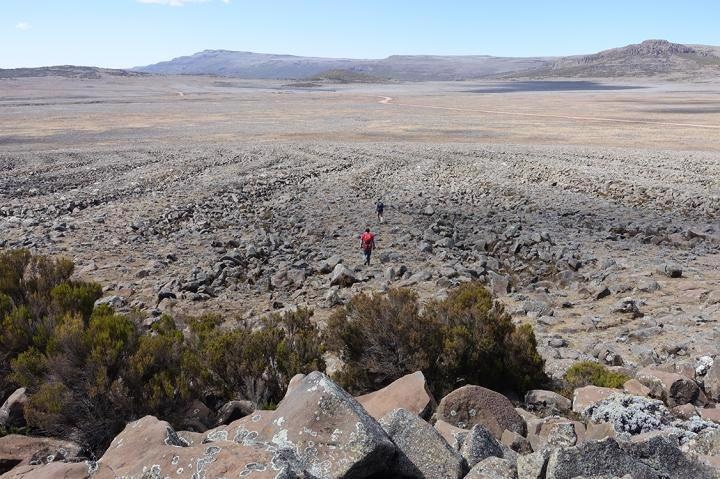Mar 15 2021
The tropics are known to drive atmospheric and ocean circulation in the world, and hence have a crucial role to play in interpreting both the past and upcoming climate change.
 The up to 200-m long, 15-m wide, and 2-m deep sorted stone strips on the southern Sanetti Plateau (ca. 3,900 m a.s.l.) were probably formed during the last glacial period under much cooler conditions and can best be explained by a natural sorting of the stones in the course of the cyclic freezing and thawing of the ground. Image Credit: Heinz Veit.
The up to 200-m long, 15-m wide, and 2-m deep sorted stone strips on the southern Sanetti Plateau (ca. 3,900 m a.s.l.) were probably formed during the last glacial period under much cooler conditions and can best be explained by a natural sorting of the stones in the course of the cyclic freezing and thawing of the ground. Image Credit: Heinz Veit.
The global climate simulations as well as the worldwide reconstructions of ocean temperatures denote that the cooling in the tropics at the time of the last cold period, which started around 115,000 years ago, was relatively weaker when compared to the polar and temperate zone regions.
But the degree to which this common statement is also relevant to the tropical high mountains of Eastern Africa and any other place appears to be questionable based on ecological, geological, and palaeoclimatic analyses performed at high elevations.
Now, a team of researchers, headed by Alexander Groos and Heinz Veit, both from the Institute of Geography, and Naki Akçar from the Institute of Geological Sciences at the University of Bern applied the Ethiopian Highlands as a test location to study the degree and effect of regional cooling on tropical mountains at the time of the last glacial period.
The study was done in association with collaborators from ETH Zurich, the University of Marburg, and the University of Ankara. The results of the study have been reported in the scientific journals Earth Surface Dynamics and Science Advances.
Formation of Plateau and Valley Glaciers
“The Ethiopian Highlands are currently not covered by ice, despite its elevation of over 4,000 m,” explained Groos, who investigated the landscape, climatic, and glacial history of the Bale and Arsi Mountains located in the southern highlands as part of his thesis.
Groos continued, “Moraines and other landforms, however, attest to the fact that these mountains were glaciated during the last cold period.”
Within the Bale and Arsi Mountains, moraine boulders were plotted and sampled in the field and subsequently dated through the chlorine isotope “36Cl” to precisely find out the timing and extent of previous glaciations.
But the investigators were in for a real surprise.
Our results show that glaciers in the southern Ethiopian Highlands reached their maximum extent between 40,000 and 30,000 years ago. Several thousand years earlier than in other mountainous regions in Eastern Africa and worldwide.
Alexander Groos, Institute of Geography
Overall, the glaciers located in the southern highlands enclosed a region of over 350 km² during their peak. Apart from the cooling of a minimum of 4°C to 6°C, the extensive volcanic plateaus located above an altitude of 4,000 m were conducive to the formation of this extent of glaciation.
The team gained a crucial understanding by making a comparison between the uniquely reconstructed fluctuations in glaciers in the Ethiopian Highlands and those of the highest East African mountains, and with the climate archives from the Great African Rift Valley.
The cross-comparisons show that the tropical mountains in Eastern Africa have experienced a more pronounced cooling than the surrounding lowlands. Furthermore, the results suggest a nonuniform response by East African glaciers and ice caps to climate changes during the last cold period, which can be attributed to regional differences in precipitation distribution and mountain relief, among other factors.
Alexander Groos, Institute of Geography
The Enigma of the Stone Stripes
When the researchers were on their fieldwork on the central Sanetti Plateau in the Bale Mountains, they also came across massive stone stripes (measuring up to 15-m wide, 1,000-m long, and 2-m deep) beyond the region of the previous ice cap.
The existence of these stone stripes on a tropical plateau surprised us, as so-called periglacial landforms of this magnitude were previously only known from the temperate zone and polar regions and are associated with ground temperatures around freezing point.
Alexander Groos, Institute of Geography
But on the Sanetti Plateau, the average ground temperature is presently around 11°C.
The huge boulders and basalt columns that constitute the stone stripes initially came from the extensively eroded volcanic plugs and rock formations.
As things stand, the investigators believe that the formation of stone stripes occurred during the last glacial period via natural sorting of the earlier randomly distributed rocks during the course of the intermittent thawing and freezing of the ground close to the former ice cap.
But at the local level, this would have required a reduction in the mean air temperature of a minimum of 7 °C and a reduction in the mean ground temperature of a minimum of 11°C.
Whether this unrivaled cooling is an exemplary or regional phenomenon for the cooling of tropical high mountains at the time of the last glacial period should be demonstrated by upcoming research works from other tropical mountain areas.
Journal Reference:
Groos, A. R., et al. (2021) Nonuniform Late Pleistocene glacier fluctuations in tropical Eastern Africa. Science Advances. doi.org/10.1126/sciadv.abb6826.